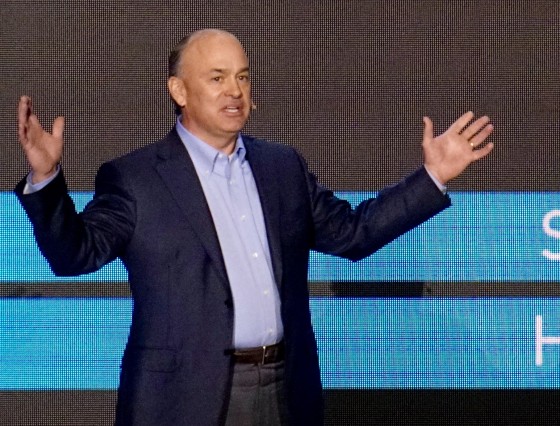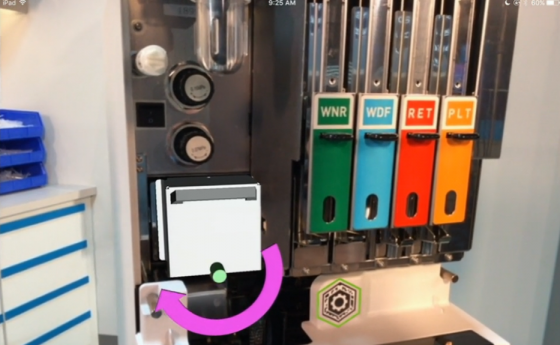PTC acquired Vuforia from Qualcomm in October 2015 for $65 million. The company has wasted little time incorporating the AR technology into its ThingWorx IoT product line.
PTC introduced its product group, Vuforia, to the world with a slick web cast called The Thing Event. The show featured Vuforia’s augmented reality (AR) technology being used as a visualization tool for service, maintenance, assembly, and other types of information access. Mike Campbell PTC’s EVP of digital twin walked the audience through customer use cases including repairing a motorcycle and servicing a hematology machine and as he did, Campbell explained how AR takes model-based design to a new level of interactivity for everyone in the lifecycle of a product.

PTC highlighted new Windows 10 support and Microsoft’s latest Surface devices including the latest Surface Pro machines and Surface Book to work with Vuforia. Applications can be built with a several industry standard tools including Unity for a cross-platform app to run on iOS, Android, and Windows 10. Now, Microsoft Visual Studio can be used to add Windows 10 support to existing apps. There was nary a whisper of Hololens, but the emphasis on Windows 10 in the context of AR, certainly begs the question.
During the show PTC revealed its new ecosystem for Vuforia within ThingWorx, which will include the ThingX Browser, ThingBuilder, the ThingServer, and also VuMark, a distinctive AR target to indicate that a product has associated AR content.

The Thing Server adds security and information management. Users sign in and are given the appropriate information for their position and the job they are doing. The ThingX Browser, is a thin browser available for all devices, which can identify products that support PTC’s ThingWorx AR, and guide users to unlock the information services. PTC has also developed TML (Thing Markup Language) to describe how to link 3D digital objects with their real-world counterparts.

Vuforia came to PTC with a considerable amount of development behind it. It has a base of more than 200,000 developers and 20,000 apps. Much have that development has been for consumer apps and also by hobbyists taking advantage of free tools and viewers. As a result, there have been over 230 million installs of Vuforia apps all over the world.
Vuforia General Manager Jay Wright told the audience “we’re at a really interesting intersection … at some point we’ll all wear a pair of glasses that will add a heads-up display to our lives. The Future of AR is on our heads.”
Summary
The company still has some details to work out. Talking to people from the Vuforia team, I was told that they intend to nurture the hobbyist base. They’ll help grow the invisible world of content that will be increasingly be associated with the things in our world. And, to that end, Heppelmann and Vuforia General Manager Jay Wright are assuming the ThingX browser is going to have to be free. Likewise, it makes sense the Thing Markup Language will have to be as open and available as HTML is. However, the PTC execs said they’re not ready to outline the details for these new tools.
PTC has been busy figuring out a lot of things for themselves too. I talked to Mike Campbell about how PTC and the ThingWorx division interact. I asked if they’re envisioning customers living in an all-PTC world. Using Creo and Windhill to design products, building in diagnostics as a result of simulation from the PTC side, and big data statistical information using Coldlight machine learning. Campbell said, not at all. ThingWorx is a platform and he has seen customers coming to them from all over the increasingly integrated ecosystem of related industries. Obviously, they’re not going to mind when customers come to them from PTC products, but ThingWorx needs to be accessible to customers across the product development world.
What do we think?
We’ve been talking a lot about the VR boom – where is it? Is it coming? does it live beyond gaming, and so on, but we have also said that AR is the real boom that is happening right now. As PTC demonstrated, the AR train is pulling into the industrial markets where it’s going to change many processes starting with services, but including documentation (another strong product line for PTC), operation, assembly, etc. There is going to be much less need for deeply trained service professionals when heads up displays can show anyone how to fix products or replace batteries.
2015 was an important year for AR. It was well known that Vuforia was in play before it was acquired by PTC. Another VR leader Metaio was acquired by Apple and so its developers were abandoned. At the Thing Event we talked to companies that have been providing AR services and they’ve expressed relief that Vuforia has ended up in the hands of PTC where there will be a commitment and understanding of the industrial markets.





